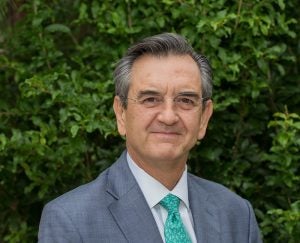
Rodolfo Lacy Tamayo is the Director of the Environmental Directorate at the OECD, where he studies the intersection of land use change, housing and urban planning. Lacy and his colleagues are determining how the development of cities can change to reduce the burden of air pollution from vehicles.
How did you get involved in clean air work?
In 1977, when I was a student at the Metropolitan Autonomous University in Mexico City, World Environment Day was celebrated with a week of panels and exhibitions about environmental problems in Mexico. One of them was the air pollution problem in the valley of Mexico. At that time there were no catalytic converters, and we used leaded gasoline. We suffered from traffic congestion and high air pollution. In the valley of Mexico, Lake Texcoco had been drained, changing the ecosystem. We were suffering from dust storms, heat waves, and of course, air pollution problems that were related to sulfur dioxide. Then, the amount of uncontrolled air pollution sources was huge, and air pollution problems were very critical.
I was a student and was very interested in working on those problems, so I started to focus my studies in environmental engineering with a specialty in air quality.
Later, I was in charge of the first comprehensive air pollution program in Mexico City and the citywide air quality monitoring network, in addition to enforcement teams and the first smog inspection program for the whole metro area.
Why do you find this work so critical, especially today?
Many of the technological advances related to air pollution control in the world are helping us now to address the global challenges related to climate change. We started with very small initiatives at local level and then found out that the pollution we were trying to tackle was related to global problems that are transforming the planet in general. I think I found in this discipline the way to really help my community, my city, my country and now the climate.
How should leaders couple climate and clean air goals?
I think leaders are seeing this problem even today with a siloed approach. But everything is related to the way we are using our resources, the energy we are selecting to give us the comfort we are enjoying and the way we are addressing technological challenges. If I need to move people from one place to another, I can choose a car as a mode of transportation that is very polluting. Or, I can design something that really solves the problem without affecting the environment or ecosystems. Now we are realizing that electric cars, vehicles in general—ships, boats, airplanes—could not only reduce but eliminate air pollution problems in our cities. We knew it several decades ago, but the siloed approach and the lack of comprehensive vision of how we can improve our quality of life without breaking all ecological cycles has been a failure. It’s clear for many people now that we have abused the planet—we have used it in an unsustainable way. We have to change the way we are living and satisfying our needs; otherwise, we will destroy the planet very soon.
How can organizations align funding to achieve both clean air and climate benefits simultaneously?
There is a revolution in the financial system, because the governing decisions in central banks and financial institutions are changing. Now we can adopt regulations to really promote low-carbon technologies or technologies that are not emitting any pollutants. Many financial institutions recently stopped financing or investing in coal. This is a new attitude of central banks and the financial system. The changes that we are now seeing are related to consciousness, the knowledge we have about how very profitable investments are really destroying ecosystems, our way of life and our quality of life. So instead of promoting and subsidizing oil and gas industries, mining activities and petrochemical corporations that are producing very harmful and toxic substances and materials, the financial system is willing to invest in technologies that we must massively deploy to protect natural resources.
I think that the financial system is changing, and we can see it is avoiding climate risks. They are requiring different kinds of assessments to make decisions about what kind of portfolios they will be promoting. That these institutions are now making good decisions for the future is a positive sign.
What gives you reason to hope?
Under the Paris Agreement and the Kyoto Protocol, we were addressing 6 greenhouse gases. But recently, with the advances of science, the IPCC has started to talk about 13 different climate forcers. We must reduce emissions of those climate forcers that are increasing the temperature and exacerbating the greenhouse gas effect, including short-term pollutants like black carbon. We have to expand the scope of work of many of the policies that countries are implementing now. Otherwise, we will not be able to tackle the climate challenge or improve the quality of life of people in cities, because we are not really reducing those pollutants that are affecting air quality and the climate system as a whole.
We can see that the agendas to tackle air quality and greenhouse gases are overlapping more and are converging in a common set of policies, decisions and regulations that are more comprehensive, and that will help us solve the problem in an integrated way.
